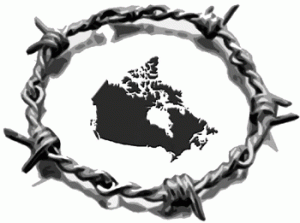Refugee claim statistics, January-June 2008
 Total number of claims: 16,690 (if the same rate continues for the rest of 2008, we can expect 33,380 at year end, compared to 28,179 in 2007). The percentage of claims made at the land border continued to rise slightly:
Total number of claims: 16,690 (if the same rate continues for the rest of 2008, we can expect 33,380 at year end, compared to 28,179 in 2007). The percentage of claims made at the land border continued to rise slightly:
51% of claims were made inland (52% in 2007, 62% in 2006)
31% of claims were made at the US-Canada border (29% in 2007, 20% in 2006)
18% of claims were made at an airport (19% in 2007, 18% in 2006)
The distribution between regions remained similar to 2007:
60% in Ontario (59% in 2007, 63% in 2006, 69% in 2005)
32% in Québec (34% in 2007, 30% in 2006, 24% in 2005)
5% in BC (5% in 2007)
3% in Prairies (451 claims) (2% in 2007)
Top offices where claims made:
Etobicoke: 27% of all claims
Fort Erie Peace Bridge: 14%
Montreal inland: 10%
Trudeau Airport: 10%
Lacolle: 8%
Toronto airports: 7%
Windsor Ambassador Bridge: 3%
Vancouver inland: 3%
389 claims were found ineligible. Of these, 73% (285) were ineligible based on safe third country.
The top country of origin of claimants continued to be:
Mexico: 22% of all claims (down from 25% in 2007, 21% in 2006)
Haiti 13% (11% in 2007)
Colombia 9% (also 9% in 2007)
For those exempted from safe third country, 62% were exempt based on moratorium countries. This represents a constantly expanding proportion, as word gets out in the affected communities (currently the Haitian community predominantly). In 2006, 48% of safe third exemptions were moratorium countries.
160 claims at the land border were made by principal applicants who are minors (under the age of 18 years).
The statistics continue to show the impact of safe third country on Colombians. In 2004, before safe third, 97% of claims by Colombians were made at the land border. From January to June 2008, 53% (782) of claims by Colombians were made inland (45% at the land border). It is reasonable to assume that many of these Colombians were forced to cross the border irregularly because they would have been turned away if they presented themselves at a border point of entry.
– from Canadian Council of Refugees



